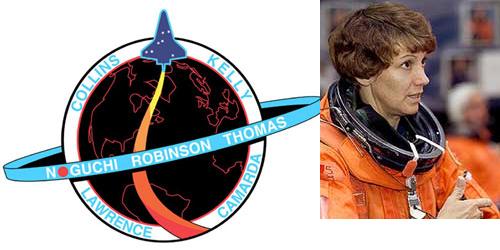Avi Blizovsky

Right: Eileen Collins, Flight 114 commander. Left: Mission Sgt
Direct link to this page: https://www.hayadan.org.il/rtf300105.html
Have you ever had a day like this?
The commander of the return flight to space - Eileen Collins had such a day. Her crew for flight STS114 practiced with the laser system that helps examine the shuttle as well as with a ventilation malfunction in the space suit. The flight controller team practiced updating the coordinate programming for the shuttle's robotic arm.
Image to left: STS-114 Commander Eileen Collins.
The good news, Collins said, is that the team, along with dozens of flight controllers and other experts trust the system and the better news is that all parts of the complex simulation - the real mission is still ahead of us.
The long simulation is excellent training for us, said Collins, we train for these tasks for a year and a half, but the simulation helps to connect all the tasks together.
The long simulation that lasts 36 hours describes the second and third days of the mission, which include operations to examine the shuttle and a meeting with the space station and docking.
The STS114 flight crew has been training together since October 2003, the crew includes 7 people - Commander Collins, Pilot James Kelly and mission specialists Charles Camarda, Wendy Lawrence, Nogozzi, Stephen Robinson and Andrew Thomas.
The crew members worked as one unit for many hours and symbolized walking in space, performing possible repairs according to a list of malfunctions. The simulation was the biggest challenge they went through.
The simulation includes many stages, the team itself was divided between simulation tasks in the shuttle and tasks in the space station facilities, as well as teams also trained for control tasks which are defined teams just like the shuttle team.
According to Darrel McGregor, who is responsible for creating the simulation, long simulations are useful for training communication, coordination and teamwork between the crew and the flight control team. Paul Hale - the person responsible for the mission agrees "this is important for creating an atmosphere of interaction and assessments for everything that can happen".
During the simulations, the flight controllers work for 36 hours, including changing shifts around the clock.
The first 24 hours symbolized the first 2 days of the flight, a significant part of which is dedicated to examining Kahapi and even the ferry. The team is training to operate state-of-the-art equipment that includes a laser sensor operated by the shuttle's robotic arm to examine the required areas.
The space station controllers joined the simulation during the last 12 hours for docking operations, they examined the possibility of photographing and examining the shuttle's shield tiles as it approached the space station and practiced making transfers from the shuttle's robotic arm to the space station's robotic arm.
A simulation that depicts this complex takes months of planning, McCregor and his simulation design team worked with shuttle and space station simulators to produce the required script.
The ultimate goal is to reach a regular flight, the way to get there is not through a smooth simulation but through the examination of dozens of malfunction scenarios. There is no choice of mistakes by chance, emphasized McCregor.
The selection of the scenarios is carried out by experts.
During the simulation itself, faults are transferred by pressing a button or clicking a mouse. Usually, additional faults are introduced so that the entire crew, including the flight controllers, is on alert.
As for the controllers, they spend most of the days working one-on-one with the staff members, instructing them to operate the many systems.
I think this is one of the most interesting missions in the world, knowing how to train the team in the procedures they will use during the mission, said Chris Edwards, data processing and navigation systems instructor. His friend Michael Gervis agrees - we are on the front line of the shuttle mission, the training is the next best thing after the mission itself he noted.
Most shuttle crews go through only one simulation, however the current crew is supposed to go through additional simulations of 36 hours and 48 hours. The large number of simulations in the mission is in light of the complexity of the mission mainly in light of the freezing of the missions for nearly two years. Such simulations help everyone to be in focus.
Before this simulation, the largest simulation the team had gone through was only 10 hours long.
For information on NASA's website
Yadan returned to the flight
https://www.hayadan.org.il/BuildaGate4/general2/data_card.php?Cat=~~~70225050~~~188&SiteName=hayadan
